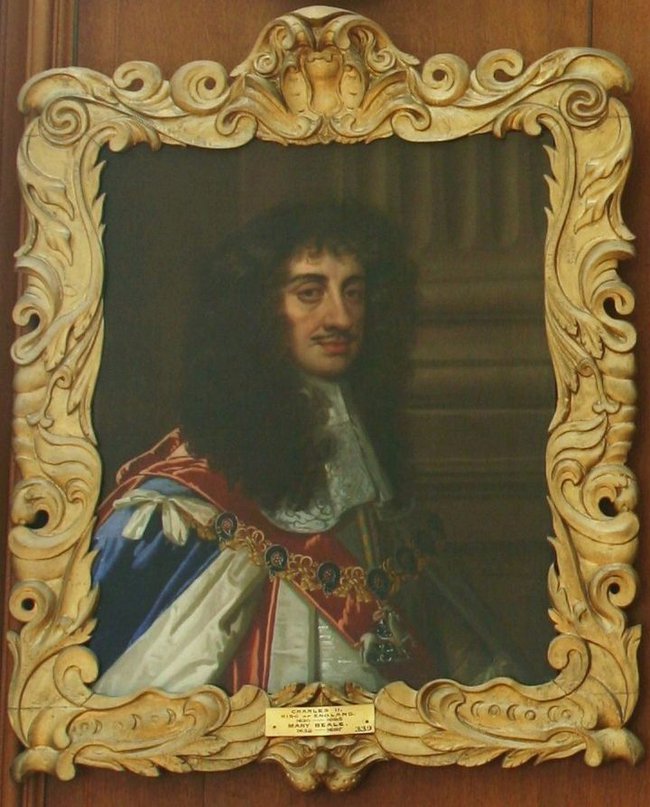7.1 A Preliminary Note on Terminology
‘Auricular’, referring to the external part of the ear, was a late 19th century name for ornament of the 17th century that is characterised by its unsettling evocation of cut, flattened, twisting and overlapping supple animal skin, smooth undulating bodily forms, fluid lines, often with an undulating silhouette, fantastic animal and human masks.1 This term remains in general use when describing this stylistic category. However, this article will use the terms ‘Leatherwork’ or the Dutch ‘kwab’ respectively for 17th-century auricular frames of English or Netherlandish production because they are historically and culturally located terms that help evoke their particular qualities.
In his catalogue for the Rijksmuseum’s 2018 exhibition on auricular in the Netherlands, Reinier Baarsen states that the Dutch term ‘Kwab is the somewhat unsatisfactory but graphic word used in the Netherlands [meaning] a flabby fold or thickening, for example of a human or animal body […] the word kwabornament was invented in the late nineteenth century’.2 Baarsen prioritises kwab as an historical description for Netherlandish auricular ornament, including picture frames. However, some other Dutch terms were also used during the mid-17th century such as snakerij, meaning drollery or prank, and konstig (kunstig in modern Dutch) meaning artificial and unusual – beautiful things made with special skill.3 Picture frames carved with this kind of ornament have been researched and presented at two exhibitions at the Rijksmuseum: Prijst de Lijst in 1984, and Kwab in 2018.4 The catalogue for Prijst de Lijst – published in English in 1995 as Framing in the Golden Age – has individual entries for over twenty Dutch auricular frames, based on a survey of 450 original framings. It is notable that only a minority of these frames were kwab examples.5
‘Leatherwork’ is a 17th-century name for English frames which are now referred to as being made in the auricular style. The term was being used in England to refer to carving in this style by at least the 1670s and helps us to understand how it was perceived at the time. Jacob Simon notes the term occurring as:
‘guilt [sic] leatherworke frame’ in the executorship accounts of Sir Peter Lely in about 1680. The term also appears in the accounts of Grinling Gibbons in 1697 and 1701 […] What does the description ‘leatherwork frame’ imply? The frames were clearly of wood and not of leather but, as H. Avray Tipping explained of this type of carving in his book on Grinling Gibbons, ‘in its appearance of being made out of a material that could easily be cut, bent and rolled made it retain […] the name of ‘leather work’.6
The English portraitist Mary Beale (1633-1699) was an admirer and imitator of Sir Peter Lely (1618-1680), a leading Dutch-trained artist who used Leatherwork frames throughout his career in London [see fig. 26, 27 & 36].7 Her 1677 and 1681 Pocketbooks list the types of frame she used – the most expensive pattern was the ‘leatherwork gilt frame’.8 This description corresponds to the anonymous design of the English carved and gilded oak frame on a portrait attributed to Beale of Charles II, which is typical of the 1670s [1].
Since the 19th century, however, this sort of design has become known as a ‘Sunderland’ frame pattern, after the 2nd Earl of Sunderland’s 17th-century collection at Althorp House where the type is prevalent.9 The Sunderland pattern can be characterised by its irregular outer and inner edges, lion cartouche at top centre, interwinding scroll at each top corner and then, down either side and around the bottom corners, a complex series of reversing scrolls with foliate and ribbed elements, finally meeting one of a few alternative masks at the bottom centre. ‘Sunderland’ has become commonly used to describe English auricular frames in general, including many patterns not found at Althorp. It would be clearer to use the ‘Sunderland’ term for the specific pattern seen at Althorp and elsewhere [Figs. 1 & 36], and to use ‘Leatherwork’ as the overall term for all English auricular frames.
‘Strapwork’ ornament – derived from stiff, cut, interweaving and scrolling leather – had been well established in Britain since the sixteenth century, and was influenced directly by prints from the Netherlands. A drawing by Sir Balthazar Gerbier (1592-1663) of about 1616 [2] indicates the evolution of strapwork into the softer auricular. Baarsen states that ‘portrait engravings featuring auricular cartouches began to be published in England itself from about 1617; most of those were indeed produced by designers or engravers who either came from the Netherlands or had close contacts there’.10 Gerbier, a designer, courtier and diplomat, was born in Middelburg and moved to England in 1616, becoming an agent for the Duke of Buckingham, and buying pictures for him in Italy.11 He is an example of the kind of person well-placed to facilitate exchange between Italy, England and the Netherlands.

1
Attributed to Mary Beale
Portrait of Charles II
oil on canvas / gilded oak frame
Althorp House (painting 339)
Image: A Johnson, 2008

2
Balthazar Gerbier d'Ouvilly
Portrait of Frederick V, Elector Palatine (1596-1632) in a cartouche, c. 1613-1616
London (England), British Museum, inv./cat.nr. 1854,0628.77
Notes
1 Roberts 2018.
2 Baarsen 2018, p. 11.
3 Communication between the author and Ada de Wit, 2022.
4 Van Thiel/De Bruyn Kops 1995; Baarsen 2018.
5 Van Thiel/De Bruyn Kops 1995, nos. 33-39, 43-44, 47-48, 55-57, 61, 66, 70-71, 73-76. This article is based on the author’s images collection of over 700 examples of English auricular frames, as well as several hundred Italian and Dutch examples – including the physical examination and analysis of as many as possible.
6 Simon 1996, p. 55.
7 Grosvenor 2019, p. 18.
8 Talley 1981, p. 298-305.
9 The earliest mention of ‘Sunderland’ frames known to Jacob Simon is by George Scarf, ‘Portraits of Judges in the Guildhall’, in 1893. Simon 1996, p. 55.
10 Baarsen 2018, p. 210.
11 Skogh 2015.

